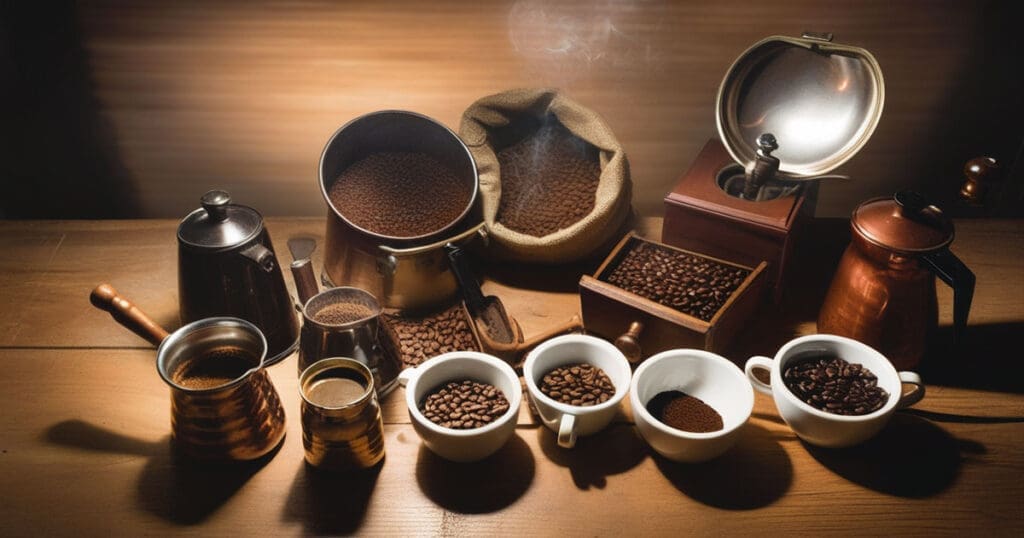The journey of coffee roasting is at the heart of our favorite drink. It's key to know about coffee roasting levels for those who love specialty coffee. As green coffee beans change, things like temperature, time, and where they come from are important.
These elements help create unique flavors and smells that make our coffee special. This guide will help us understand coffee roasting better. We'll learn to appreciate the skill needed to make the perfect cup.
What is Coffee Roasting?
The coffee roasting process turns raw coffee beans into the tasty drinks we love. It involves drying, browning, and creating unique flavors. Heat is key in this art.
The Basics of Coffee Roasting
Heat changes coffee beans in the roasting process. First, the beans dry out. Then, the sugars caramelize, adding flavor. The final stage lets us fine-tune the taste with temperature control.
The Role of Heat in Roasting
Heat is crucial for coffee's taste and smell. Roasting temperatures range from 350°F to 500°F. Each roast level needs careful temperature control for the perfect flavor.
Roasting methods vary, offering a wide range of flavors. With a good guide, we can roast coffee to perfection, making every cup special.
The Importance of Roasting Levels
Understanding roasting levels is key to enjoying coffee. Each roast level changes how flavors develop in the beans. This affects our coffee experience.
We'll see how roasting levels impact coffee flavor and aroma. This includes acidity in coffee.
Flavor Development
Exploring coffee flavor, we find that each roast level brings out unique flavors. Light roasts highlight fruity and floral notes. Medium roasts balance sweetness and acidity.
Dark roasts offer a bold taste with chocolate and caramel notes. This shows how roasting shapes the flavors we love. It lets us pick a roast that suits our taste.
Aroma and Acidity
The aroma and acidity of coffee tie back to roasting levels. Heat releases compounds that shape the scent. Light roasts have a bright, lively aroma with high acidity.
Medium roasts offer a rounded aroma with moderate acidity. Dark roasts have a robust aroma and lower acidity, leading to a smooth finish. Knowing these details helps us pick the perfect roast for a great cup of coffee.
The Different Coffee Roasting Levels
Exploring coffee roasting levels reveals the unique qualities of each. We dive into light roast coffee, medium roast beans, and the rich dark roast flavors. These choices shape our coffee preferences.
Light Roast
Light roast coffee is known for its bright acidity and lively flavors. It keeps the bean's original taste, often showing fruity and floral notes. Coffee lovers enjoy its clean, crisp taste, perfect for delicate brewing.
The roasting process highlights the coffee's complex flavors. This makes light roast a top pick for those who love a nuanced cup.
Medium Roast
Medium roast beans offer a balanced taste that many enjoy. They blend acidity and sweetness, with a rich aroma and flavors. The roast's caramelization adds subtle chocolate notes, creating a comforting taste.
It's a versatile choice, loved by many. Whether you take it black or with cream, it's a favorite.
Dark Roast
Dark roast flavors bring boldness and richness. They have deep chocolate and caramel notes, with lower acidity for a smooth taste. The roasting process enhances the bean's oils, creating those deep, satisfying flavors.
For those who prefer a strong coffee, dark roast is ideal. It offers a rich experience that lingers after each sip.
How Roasting Affects Flavor
The roasting process is key in coffee, shaping our taste. It's fascinating to see how roasting changes the flavor. The science behind it shows how caramelization creates the wide range of tastes we enjoy.
Caramelization Process
Caramelization happens when coffee beans' sugars break down during roasting. This creates a variety of flavors. Lighter roasts are sweeter, while darker ones are richer and more complex.
Bitter vs. Sweet Notes
It's important to know the balance between bitter and sweet in coffee. Lighter roasts are fruity and sweet, while darker ones are bold and bitter. By understanding these, we can brew coffee that suits our taste preferences.
What is a Light Roast?
Light roast coffee is special because of its bright and flavorful taste. It has a light body and a sharp acidity. This makes it perfect for those who love vibrant coffee flavors.
Characteristics of Light Roast
The main features of a light roast are:
- Bright Acidity: Light roasts have more acidity than darker ones.
- Light Body: They feel lighter in your mouth, making them refreshing.
- Fruity and Floral Notes: You might taste berries, citrus, or floral hints.
Flavor Profiles
Light roasts offer a variety of flavors. You can expect:
- Fruity: Flavors like apple, pear, or tropical fruits are common.
- Floral: Some beans might have hints of jasmine or chamomile.
- Complexity: Each cup is unique, with layers of flavor.
Best Brewing Methods
To enjoy light roast coffee, use the right brewing method. Here are some top choices:
- Pour-Over: This method brings out the coffee's delicate flavors, making it crisp.
- AeroPress: It's versatile and can highlight the coffee's sweetness and brightness.
- Chemex: Its thick filters result in a smooth, balanced cup.
Diving into Medium Roast
Medium roast coffee is a favorite among coffee lovers. It's known for its perfect mix of flavor and body. Knowing about medium roast helps us enjoy its smooth and rich taste.
Characteristics of Medium Roast
Medium roast coffee has a great mix of acidity and body. It's roasted between 410°F to 425°F. This lets the flavors develop well without hiding the beans' natural taste.
The result is a full-bodied coffee that's not too bold. It's a joy to drink.
Flavor Profiles
Medium roast coffee tastes different for everyone. You might taste nuts, chocolate, or caramel sweetness. It's perfect for both new and experienced coffee drinkers.
It lets everyone find a flavor they love.
Popular Beans for Medium Roast
Colombian and Brazilian beans are top choices for medium roast. Colombian beans have a balanced flavor with bright acidity. They're a hit for medium roasting.
Brazilian beans are smoother and less acidic. They bring out nutty and chocolaty flavors. Trying these beans can make your coffee taste even better.
Exploring Dark Roast
Dark roast coffee is loved for its bold, intense flavors. It has unique traits that set it apart. The beans are roasted longer, making them less acidic and richer.
This longer roasting time also brings out oils on the surface. These oils add to the coffee's depth and richness.
Characteristics of Dark Roast
Dark roast coffee is known for:
- Bold flavors that dominate the cup.
- A smooth mouthfeel due to reduced acidity.
- Natural sweetness from caramelization, often reminiscent of chocolate.
- Oily surface that signifies an extended roasting process.
Flavor Profiles
Dark roast coffee has a range of enticing flavors. We love the mix of:
- Chocolate, creating a rich and satisfying experience.
- Caramel sweetness, balancing the boldness of the roast.
- Hints of smokiness that can enhance the overall depth.
- Nuttiness, offering a comforting undertone that appeals to our taste buds.
Best Brewing Techniques
To get the most out of dark roast, we need to know the best brewing methods. Here are some:
- French Press: Excellent for preserving the rich oils and full body.
- Espresso: Ideal for a concentrated shot that showcases dark roast attributes.
- AeroPress: Versatile and allows for a smooth, rich brew.
- Pour Over: Provides control over brewing time, highlighting the unique flavors.
Trying out these brewing techniques lets us enjoy dark roast coffee's complex flavors. It takes our coffee experience to new levels.
How to Choose Your Roast Level
Choosing the right coffee roast level can seem daunting at first. But, by considering our individual coffee taste preferences, we can make this decision much easier. Understanding the distinct characteristics of light, medium, and dark roasts helps us tailor our brewing choices to match what we enjoy most.
Consider Your Taste Preferences
When we think about our coffee taste preferences, several factors come into play. These include sweetness, acidity, and the body of the coffee. Here are some things to consider:
- Sweetness: Light roasts tend to have a brighter, sweeter taste, while dark roasts often deliver bold, rich flavors.
- Acidity: If a tangy, vibrant acidity excites our palate, light to medium roasts might be the way to go.
- Body: Those who prefer a fuller mouthfeel may lean toward dark roasts, as they usually offer a heavier and smoother experience.
The Importance of Freshness
The importance of fresh coffee cannot be overstated when choosing a roast level. Freshly roasted beans provide the utmost flavor impact, enhancing our overall coffee experience. To maximize taste, we should aim to brew with beans that have been roasted recently. Consider these tips:
- Purchase beans from reputable roasters known for their quick turnover.
- Store coffee in an airtight container to maintain its freshness.
- Brew coffee within a few weeks of the roast date for the best flavor.
By understanding our coffee taste preferences and prioritizing the importance of fresh coffee, we create a personalized coffee journey that is both enjoyable and flavorful.
Home Roasting Techniques
Exploring home coffee roasting techniques is exciting for coffee lovers. It lets us customize flavors to our liking. With the right equipment and practice, we can turn raw beans into a perfect brew. Let's explore what we need for this journey.
Equipment Needed
To start roasting at home, we need some basic tools. Here are the essentials:
- Coffee Roaster: A good coffee roaster, like the Behmor or FreshRoast, ensures consistency.
- Stovetop Popcorn Popper: A budget-friendly option for roasting.
- Air Fryer: Surprisingly, it's a great tool for roasting beans at home.
- Thermometer: It's key to monitor temperature for the right roast.
- Stirring Utensil: Helps in evenly roasting the beans.
- Cooling Tray: Quick cooling stops the roasting process.
- Green Coffee Beans: Fresh, high-quality beans are crucial for success.
Step-by-Step Roasting Process
Mastering home roasting is simple. Here's a step-by-step guide to get us started:
- Prepare Your Equipment: Set up your roasting gear and make sure it's clean.
- Measure the Beans: Start with 4 to 6 ounces of green coffee beans.
- Heat the Roaster: Preheat to 375°F to 450°F.
- Add the Beans: Pour the beans into the roaster and start roasting.
- Monitor the Roast: Watch for color changes and listen for the first and second cracks.
- Cool Down: Stop the roast by cooling the beans in a tray.
- Enjoy: Store the beans in an airtight container and brew a fresh cup.
Home coffee roasting lets us enjoy unique flavors tailored to our taste. Each roast is an adventure to our perfect coffee.
Understanding Roasting Profiles
Exploring coffee, we find that roasting profiles are key. They help us understand the flavors and smells that coffee develops when roasted. Each batch of roasted coffee beans has its own unique roasting profile. This lets us see the special details of our favorite drink.
What is a Roasting Profile?
A roasting profile shows the temperature and time changes during roasting. Different beans react differently to heat, changing their taste and feel. Things like the bean type, moisture, and where it's grown can affect the profile. Knowing about roasting techniques helps us see how these factors mix to create unique tastes.
How It Affects Your Coffee
The impact of roasting profiles on coffee is huge. Each profile can bring out certain flavors, like fruity or nutty. For example, a light roast might show off acidity and floral notes. On the other hand, a dark roast might offer bold, rich tastes with a deeper bitterness.
By trying out different roasting profiles, we can make our coffee taste just right. This makes our coffee experience even better.
The Coffee Bean Origin and Roasting
Learning about coffee bean origins makes us appreciate the flavors in our coffee more. Each region adds its own special touch to taste, aroma, and acidity. For example, Ethiopian beans often have bright citrus notes, while Colombian beans are rich and chocolaty.
Knowing these differences helps us understand what to expect from different origins.
Regional Differences
Exploring coffee bean origins opens up a world of regional coffee differences. The environment, altitude, and climate all shape the beans. Soil and rainfall also play a part in these unique traits. For example:
- Central American beans are smooth with nutty undertones.
- Brazilian coffee has a creamy body with chocolate notes.
- African coffees, like those from Ethiopia and Kenya, are known for their vibrant acidity and fruity flavors.
Combining Origins with Roasting Levels
Mixing different origins and roasting levels can enhance our coffee experience. Blending beans from various regions creates complex flavors. For instance, a medium roast of Ethiopian beans might highlight fruity notes, while a Brazilian bean adds chocolatey depth.
Trying different combinations lets us customize our coffee to our liking. This way, we can enjoy a wide range of delightful coffee experiences.
Conclusion: Your Coffee Journey
Our journey through coffee roasting levels is just the beginning. It invites us to explore more flavors. Whether you prefer light or dark roasts, there's always something new to try.
Experimenting with Roasting Levels
Exploring different roasts reveals a world of flavors. Each roast has its own unique taste. Joining cupping sessions or local coffee meet-ups can deepen our understanding.
Finding Your Perfect Cup
Finding our perfect cup is the ultimate goal. By trying different roasts and methods, we can find what we love. This journey not only deepens our love for coffee but also makes our daily lives better. Let's enjoy this journey together and find our ideal brew.
Disclaimer:
Some of the links on this site are affiliate links, which means I may earn a small commission if you make a purchase through them, at no additional cost to you. Thank you for supporting Brew Sip Repeat!




Facebook Comments